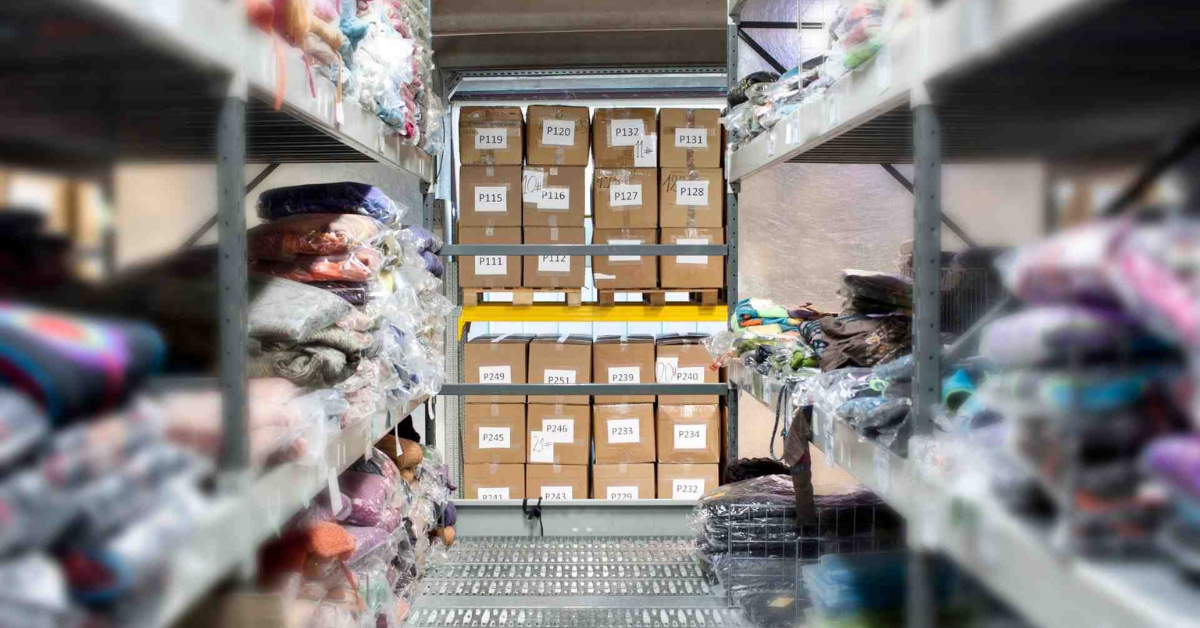Are you ready to take control of your Inventory with Versa Cloud ERP’s Essentials Guide on Inventory Types and the Best Practices for Inventory Management?
What is Inventory?
Inventory can be broadly defined as any merchandise or specified material that a business keeps at hand to manufacture or procure for sale. It comprises all raw materials, components under progress, and finished goods that a business has.
Think of it as the “stuff” that a business uses to create and sell its products or services.
Key aspects of inventory:
- Types: Inventory can include raw materials, components, work-in-progress, finished goods, and even maintenance, repair, and operating (MRO) supplies.
- Purpose: Inventory is maintained so that businesses can continue production, customer demands can be met, and smooth operations can take place.
- Value: Inventory represents a sizeable investment for businesses, and its value does need tracking and management.
- Location: Inventory may exist in different places; warehouses, distribution centers, retail stores, and, of course, in transit.
- Management: Essentially, proper inventory management is a must to keep expenditures in check, prevent stockouts, and improve cash flow.
Why is inventory important?
- Meeting customer demands: Inventory availability means that customer orders will be met on time.
- Supply support to production: Providing the necessary material for manufacturing operations is inventory.
- Keeping operations flowing: Inventory carries the supplies needed to keep businesses running.
- Revenue generation: Whereas inventory is ultimately sold, revenues; thus, they earn profit for the company.
In short, inventory is an important asset of any business, and proper control of this asset is critical.
Key Takeaways: Knowing Inventory
- Types of Inventory: There are various modes in which inventory can exist from raw materials to components to finished goods readily available for sale.
- Tracking the Inventory Towards Accuracy: Watching your inventory would help you to make wise decisions to cut up on the wastage of resources.
- Opening the Eye-Through Analysis: The inventory data will provide the eye to the business on how performing is it and show it the weak areas that still require work.
- The Benefits of Effective Management: By mastering inventory management, you can increase customer satisfaction, boost profitability, and drive business growth.
Inventory: The Lifeblood of Business Operations
Inventory, in many respects, is defined as the lifeblood of an enterprise; it provides a link between producing products and getting them into the hands of willing customers. You have raw materials from those used in production to the ready-to-be-shipped finished goods.
Importance of Inventory Management
Refer to it as a . You have to make decisions about what goals to reach with your garden: which plants (products) will thrive, enough water (stock) to keep the plants alive, and the right tools (management systems) to keep it functioning properly.
Perfect inventory management should:
- Ensure Customers Remain Happy: The right product well-stocked means happy customers taking their orders on time.
- Ensure Good Cash Flow: Avoid allotting too much money to excess stock, and ensure smooth flow of stock into and out of business operations.
- Improve Your Bottom Line: The value loss by waste, obsolescence, and stock out should be reduced to have a healthier bottom line.
- Improve Business Operations: Make your purchase and supply operations more efficient so that your business runs more smoothly.
Examining your Inventory
Managing an inventory successfully requires that you know what you have, where it is located, and how quickly it is moving. Such evaluations include:
- Raw materials: All the ingredients or inputs for completing finished goods.
- Work-in-progress: Any product that is still in the work-progress stage.
- Finished goods: Completed products ready for sale.
- Safety stock: Additional stock designed to act as a buffer against unexpectedly higher demand or failures within the supply chain.
You will, therefore, be able to effectively manage your purchasing, production, and fulfillment activities when you keep an eagle eye on the various forms of inventory to allow full operations to take place.
A Comprehensive Guide on Inventory: The Varied Types
Inventory can be mainly categorized under four main heads: Raw Materials, WIP, Finished Goods, and Maintenance Repair and Operations. A business uses these categories to track and stock items under these heads to determine what is available and what will be required in the future to support operations.
The Four Types of Inventory are:
- Raw Materials: This encompasses the basic supplies or run-in materials used in the production of finished products. Examples could include wood for furniture, steel for cars, or flour for baked goods. Raw materials must be efficiently managed to ensure a smooth production process without interruptions.
- Work in Progress (WIP): These are the inventories of partially finished goods. Think of the car that is half-completed on an assembly line or the dress that has been cut but not yet sewn. Monitoring WIP allows you visibility into how production is advancing and might reveal where bottlenecks may occur.
- Finished Goods: These are the products ready to be sold to customers. The finished goods inventory includes smartphones, clothing, cars, and furniture, among others. Management of this inventory is crucial to ensure demand from customers is met, thereby maximizing sales.
- Maintenance, Repair, and Operations Supplies (MRO): This includes all items or supplies required to keep the working aspect of any company progressing, like cleaning supplies, office supplies, and repair parts for equipment. This inventory may be a bit tricky due to its diversity, yet it’s just as important as the other inventories.
Additional Types of Inventory
- Components: all assemblies and parts on which the finished product is based for use or, broadly translated, an assembly used in a finished product, e.g. a car engine or a computer chip.
- Packaging: Boxes, Labels, Bubble Wrap, and Packing Peanuts.
- Safety stock: Used to create excess inventory as a buffer against unexpected demand or supply chain problems.
- Anticipation: This is committed inventory purchased to satisfy future demands, such as seasonal items or products expected to rise in their purchase price.
- Decoupling inventory: Materials and parts are kept in between processes in production to avoid bottlenecks and to ensure a smooth operation of the processes.
- Cycle inventory: A batch of inventory ordered for routine demand.
- Service inventory: State of how a service organization can meet demand, for example, the number of vacant rooms in a hotel.
- Transit inventory: Inventory that is in transit between two locations, e.g., goods being shipped from a supplier or to a customer.
- Theoretical inventory: The minimum possible inventory level under which production is delayed because an order is yet to arrive on time.
- Excess inventory: Obsolete, damaged, or simply unneeded stock.
The Importance of Knowing about Different Types of Inventory
- Improved Management: With knowledge of the various types of inventory, it becomes possible to put in place perfectly suitable management for each while establishing optimum stock levels, minimizing costs, and preventing waste.
- Timely Accounting: Proper classification of inventory is important for determining operating accounts and for making financial statements.
- Better Decision-Making: Knowing your inventory composition will allow you to make decisions about production, purchasing, and sales much more intelligently.
With such a thorough understanding of the various types of inventory, a business executive shall be in a very good spot of being able to manage its existing assets, fine-tune its operations to boost efficiency, and increase its profitability.
Inventory in Action: Real-World Examples Across Industries
Inventory can be very confusing, but real-world examples can clear this out. Let us now see the different types of inventory in action in different businesses:
1. Raw Materials/Components:
- T-shirt Company: Pretend you have a company that manufactures T-shirts. The raw materials could be fabric, threads, dyes, and the designs being printed on the shirts.
2. Finished Goods:
- T-shirt Company (continued): Finished goods once the T-shirts have completed printing, folded, and packaged are ready for sale. The finished good value includes the cost of raw materials along with labor and packaging costs.
3. Work in Progress (WIP):
- Smart Phone Manufacturing: It is a very labor-intensive process. A smartphone goes through several steps from component assembly (touchscreen, processor, battery, etc.) until it is totally completed. Currently, it is a work in progress.
- Good Simple Example: Even producing the phone case or screen protector involves a work-in-process phase, as the materials go from unfinished to finished product.
4. Maintenance, Repair, and Operations (MRO) Goods:
- Condominium Community: Think of all the things necessary to run a condo complex: cleaning supplies, office supplies, gardening equipment, and repair equipment. These are all MRO goods.
5. Packaging Materials:
- Seed Company: A seed company experiences three different levels of packaging:
- Primary: This is where the small seed packets keep the seeds from exposure.
- Secondary: Boxes that hold multiple seed packets.
- Tertiary: Wooden pallets and shrink wrap used to move large numbers of boxes.
6. Safety Stock:
- Veterinary Clinic: A veterinarian in a remote area could stock certain important medications required for emergencies and supplies should the roads become closed or impassable.
7. Anticipation Stock:
- Event Planner: An event planner could purchase decorations and supplies in advance in anticipation of wedding season.
8. Decoupling Inventory:
- Bakery: A bakery may have to keep a stock of made decorations to continue decorating cakes for some time during the delay in frostings supply.
9. Cycle Inventory:
- Restaurant: A restaurant will be placing an order for new napkins as soon as the current ones are almost over.
10. Service Inventory:
- Cafe: A cafe with limited seating has a service inventory based on how many customers they can serve during their operating hours.
11. Theoretical and Book Inventory:
- Restaurant: A restaurant could take disproportionate inventory counts in which they compare what an ideal food cost should be versus the actual that would have fallen in a hole for wastage or inefficient stock keeping.
12. Transit Inventory:
- Art Store: An art store has transit inventory with whatever is ordered and paid for but is still shipped to him.
13. Excess Inventory:
- Shampoo Company: Any shampoo company would have excess inventory left with it owing to the left-out Olympic-themed shampoo after the Olympics.
Understanding these real-world examples puts one in a better position to understand the roles played by different types of inventory in various businesses.
Optimizing Inventory Management: Best Practices for Success
Inventories, when properly managed, will be transformed into an engine working very smoothly, allowing for the right product to be put in the right place and at the right time. Here are the most prominent practices to help you optimize the previous advisement with higher efficiency and control over costs with increased customer satisfaction.
- Track Everything:
It is indeed impossible to manage what has not been measured. Accurate inventory tracking provides the foundation for effective inventory management. It involves the knowledge of what is present, the location of the inventory, and the speed with which it is moving.
- Maintain Safety Stock:
Safety stock can be considered insurance against unforeseen disruptions. The challenge is to keep a buffer stock of key products or materials so as to maintain operations uninterrupted in the presence of unexpectedly higher demand or delays in the supply chain.
- Embrace Cloud-Based Inventory Management:
Cloud-based inventory management systems allow you to track your inventories in real time across various locations. It affords you the liberty to plan better with the reallocation of stocks and remain nimble when it comes to responding to changes in demand.
- Implement Cycle Counting:
Cycle counting refers to performing regular mini-inventories. This entails counting some portion of an inventory every day. This provides you with earlier and easier identification of discrepancies, greater accuracy, and less need for a full physical inventory.
- Utilize Batch/Lot Tracking:
Batch/lot tracking enables product trace-back to their origins so as to obtain valuable information with regards to expiration dates, details on the tracking date of production, and any conceivable quality issue. Such tracking is essential for businesses dealing in perishable goods or dealing with established regulatory frameworks.
You can turn your inventory management from functional to strategic rewards by embracing these best practices.
Inventory Turnover: A Pulse Check of Your Inventory
Inventory turnover helps gauge the quality of performance of your company’s inventory management. This is a clear even unambiguous way of gauging how fast an enterprise utilizes or sells its goods, thus providing valuable insights into their sale performance, inventory management, and operational efficiency.
What Is Inventory Turnover?
Simply put, inventory turnover tells the number of times the entire inventory is sold or consumed during a set period, usually a year.
Inventory Turnover Calculation
There are various methods you can use to calculate inventory turnover:
- Simple Inventory Turnover: The total sales divided by the average inventory; this gives a general idea of how fast the inventory is moving.

- Inventory Turnover Ratio: This divides COGS by the average inventory value. This is a more precise measure of how well you are using your inventory.

What the Results Mean
- Low Turnover: may mean either weak sales, excess inventory, or inefficient inventory management.
- High Turnover: provides an idea of strong sales but could signal that you may be running low on inventory or missing sales opportunities if you’re not replenishing stock fast enough.
Importance of Context
You will get the maximum amount of mileage out of inventory turnover calculations by putting it into context:
- Historical Trends: Compare your current turnover to past performance to identify trends and potential issues.
- Industry Benchmarks: Compare how your turnover stacks against other industry players so you can see how well you’re performing.
- Other: Consider things such as seasonality, promotions, and economic activity that might affect inventory turnover.
Inventory keeping is one of the cornerstones of good inventory turnover and consequently meeting the business’s objectives. These include:
- Accurate Tracking: foreseeing what you have within your stock and available locations, as well as how quickly it moves.
- Demand Forecasting: anticipating future demand to ensure the right stock is available.
- Efficient Replenishment: stocking up your inventory so that it is received without any stockouts.
- Minimization of Waste: eliminating losses from obsolescence, obsolescence-related damage, and pilferage.
Becoming an expert in inventory turnover and implementing good practices whilst doing inventory management, will lead to improvement in the cash flow, improved profits, and running of the business smoothly.
Inventory Analysis: Searching for Clues in Your Stock
Inventory analysis is like going into the stockroom with a protean gaze. It opens your mind and helps explain what you have, its movement, and how you can fix inventory act for efficiencies and profits.
ABC Analysis: 80-20 Rule in Practice
One of the ways to conduct an analysis on inventory is ABC analysis.
This is rooted in the Pareto principle, where about 80% of effects derive from 20% of causes. As applied to inventory, this indicates that probably 80% of profits come from about 20% of products.
ABC analysis enables you to divide your inventory into three categories:
- A-Items: These are highly performing items that move at a fast pace, generate the highest profits, and have low storage costs.
- B-Items: These items move at a moderate rate but have medium storage costs.
- C-Items: Items that are a slow sell. They generate the lowest profit and often have the highest holding costs.
With knowledge of how products are distributed among each category, a manager should prioritize the allocation of resources and write orders based on:
- Inventory Levels: One form of A-item must be ensured to stock sufficiently large amounts to meet demand without stock-out.
- Storage and Handling: Optimize your warehouse layout to prioritize A-items and minimize handling costs for C-items.
- Pricing and Promotions: Adjust pricing and promotions to maximize profitability for each category.
Benefits Derived from Inventory Analysis:
- Assured cash flow since no block is faced by slow-moving stock to capitalize on other, more profitable products.
- Reduced stock-out rates since they predict demand and control their best-selling products in ample stock.
- Higher customer satisfaction due to meeting customer demand and fulfilling orders without backorders.
- Less wastage resulting in reduced losses from inventory that is unsuitable or expired.
- Better relations with the suppliers as a result of better negotiation processes to optimize on one’s level of inventory they require.
- Better decision-making as valuable insights into the performance of your business are formed for data-driven decision-making.
Using inventory analysis, you will manage stock levels, improve efficiency, and boost profits.
Versa Cloud ERP: The All-in-One Command Center for Inventory Management
Effective inventory management can make or break a business. To be a successful business, real-time visibility of stock is crucial, and Versa Cloud ERP provides tools to help you effectively manage your inventory and become more efficient in it.
Versa Cloud ERP bundles a comprehensive set of features for inventory management:
- Real-Time Tracking: View your stock levels from multiple locations, warehouses, and channels.
- Replenishment: Define reorder points and automate purchase orders via a PO planner to avoid stockouts.
- Demand Planning: Accurately forecast demand to optimize inventory levels and avoid overstocking.
- Safety Stock Management: Set safety stock at an optimal level to buffer against disruptions to the business.
- Cycle Counts: Improve stock accuracy and decrease the need for full physical inventories.
Versa Cloud ERP is the right choice for companies ranging from small to mid-sized enterprises
Frequently Asked Questions on Inventory
- What is manufacturing inventory?
In manufacturing, these are raw materials, components, and finished goods. Accurate tracking is mandatory to be able to ensure timely production and cost management.
- What does inventory mean in a non-manufacturing context?
Inventory in the service sector pertains to the resources that are tied to service provision, including staff time, equipment, and intellectual property.
- What is inventory processing?
The inventory processing, from reception/storing to management/usage, followed by its lifecycle.
- What are the types of inventory?
Raw Materials/components, Work in Progress(WIP), Finished Goods, Maintenance, Repair, and Operating Supplies(MRO).
- How do you control inventory?
Inventory control is knowing how much stock is enough to meet demand, often done with inventory management and supply chain software.
- What is an inventory record?
An inventory record contains information about the items in stock, their quantity, location, value, and order history.
- What is Average Inventory Cost?
Average inventory cost is a method used to compute the per-unit cost of goods sold, usually for inventory valuation.
- What is an inventory count?
An inventory count is conducted to physically count and verify the condition of the products in stock.
To learn more about how Versa Cloud ERP can optimize your inventory management, reduce your costs, and boost your bottom line.
Take the First Step Towards Transformation
 Email: sales@versaclouderp.com
Email: sales@versaclouderp.com
 Instant Demo Registration: Demo Registration Link
Instant Demo Registration: Demo Registration Link
By taking a collaborative approach, Businesses can build a culture of continuous improvement and achieve sustainable operational efficiency without overwhelming your team or disrupting your business.
Don’t let inventory challenges hold your business back. Discover the Versa Cloud ERP advantage today.
Effectively manage your financials, multiple channel inventory, and production workflows with our award-winning ERP.
Let Versa Cloud ERP do the heavy lifting for you.
Do Business on the Move!
Make your businesses hassle-free and cut the heavyweights sign up for the Versa Cloud ERP today!!
Join our Versa Community and be Future-ready with us.
[widget id=”custom_html-20″]






